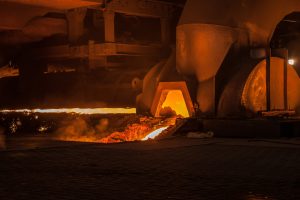On the sidelines of the G-20 summit in Rome, the United States and the European Union announced an agreement on the Section 232 national security tariffs the Trump administration placed on U.S. imports of steel and aluminum, while the United States announced ongoing talks on steel and aluminum tariffs with the United Kingdom and Japan.
South Korea’s exclusion from these talks is not surprising – unlike the EU, U.K., and Japan, Seoul reached an agreement with the Trump administration on a quota limiting its steel exports to the United States to 70 percent of the average volume between 2015-2017 (2.68 million tons a year). The quota on South Korean steel exports allowed it to avoid the 25 percent tariff that most other steel exporters faced from the Section 232 process.
Despite having a quota in place, South Korea will also likely seek to negotiate a new deal with the United States. South Korea’s quota is a hard cap on its exports and it is unable determine how to fill that quota. The new tariff rate quota for the EU would allow it to export to the United States at historical levels before facing a tariff on any exports above those levels. Presumably, the United Kingdom and Japan will reach similar agreements, placing South Korean steel producers at a disadvantage to other U.S. allies.
Perhaps more significantly, however, the EU-U.S. agreement goes beyond removing the Trump era tariffs and replacing them with a tariff rate quota. The two sides also announced that they would hold further negotiations designed to address excess steel capacity and develop measures for trade that take into account the carbon intensity of steel and aluminum. As part of these negotiations, the United States and EU expressed a willingness to invite like-minded countries to join those talks.
While South Korea is not a major player in aluminum production, as one of the world’s leading steel producers and industrial powers it will be important to have South Korea take part in any talks related to reducing the carbon intensity of steel.
According to the World Steel Association, South Korea is the world’s sixth largest producer of steel, and with heavy steel consuming industries such as shipbuilding and automobiles it has the highest per capita apparent steel use in the world.
While the U.S. steel tariffs hit a broad range of countries, it was excess capacity from China, in particular, that precipitated the Trump administration’s Section 232 national security process. That remains a challenge as China produces roughly 10 times the steel as India, the second largest producer in the world.
Chinese steel is often more carbon intense, accounting for 60 percent of the global steel industry’s emissions, something President Joe Biden and other administration officials have noted when describing the new talks as an effort to curb “dirty steel” from China.
To address the carbon intensity of steel the U.S. and EU hope to negotiate an agreement that would set standards for carbon intensity in steel; put in place policies to lower carbon intensity in production; refrain from non-market actions that might increase carbon intensity; and restrict market access for non-participants that do not meet the standards established for carbon intensity in steel.
Establishing how to enforce these restrictions will be key to the agreement’s success, but could be done by simply leaving current restrictions in place for imports of steel from non-participating countries. In addition to the U.S. Section 232 tariffs, the EU placed safeguard measures on imports of steel out of concern that the U.S. tariffs could redirect steel to European markets – something the EU is looking to extend against South Korea. While this might be an initial solution, if the agreement does expand to include other countries different measures may be needed to restrict imports from carbon intense producers.
The United States and the EU have indicated that they hope to achieve these goals within existing international frameworks, but it appears that both may be in the process of developing an initial version of a carbon border adjustment mechanism for steel, even if not in name. If that is the case, a common standard among countries would lessen some of the political concerns around the EU’s initial push for similar action.
As leading producer and consumer of steel, South Korea has significant interests in the outcome of any new measures related to the carbon intensity of steel, especially if they have the potential to further limit its access to the U.S. and EU markets. Finished and unfinished steel products are among South Korea’s top 10 exports to the United States. While steel exports to the European Union are less significant, exports of steel-intense products such as vehicles are important for South Korea’s trade relationship with the U.S. and the EU. How this process evolves and whether in time the U.S. and EU expand it to include products containing steel, will have substantial implications for South Korea’s trade.

































